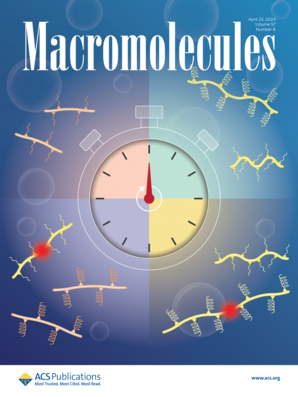Cross-Sectional Effects on Nanorod Diffusion in Polymer Melts
IF 5.1
1区 化学
Q1 POLYMER SCIENCE
引用次数: 0
Abstract
The diffusion of anisotropic nanoparticles, such as nanorods, in complex polymer environments is relevant to several scientific and industrial topics, including nanocomposites, and drug delivery. Despite recent advancements in understanding the dynamics of thin nanorods in polymer melts through scaling analyses and simulations, systematic investigations into the cross-sectional effects of nanorods on diffusion processes remain limited. In this study, coarse-grained molecular dynamics (CGMD) simulations were performed to explore the translational and rotational dynamics of a single nanorod in unentangled and entangled linear polymer melts. To introduce cross-sectional effects, we increased the nanorod diameter d, and analyzed the rotational diffusion for spinning DRS, which is distinct from the rotational diffusion for end-overend tumbling DRT. We conducted quantitative analyses to examine the scaling behavior of various diffusion coefficients with respect to the nanorod diameter, categorizing nanorods as either ‘thin’ (with diameters smaller than the tube diameter) or ‘thick’ (with diameters larger than the tube diameter). Our findings reveal a significant crossover in the scaling of the translational diffusion coefficient as d increases, while the scaling of the rotational diffusion coefficient remains almost constant. Hopping mechanisms contribute to nanorod dynamics in entangled melts, exhibiting different variations of translational and rotational dynamics with d. We finally unveiled that, the coupling between nanorod diffusion and polymer chain fluctuations enhances translational-rotational correlation at short time intervals but diminishes in the Fickian regime.

纳米棒在聚合物熔体中扩散的截面效应
各向异性纳米颗粒(如纳米棒)在复杂聚合物环境中的扩散与一些科学和工业主题相关,包括纳米复合材料和药物输送。尽管最近通过尺度分析和模拟在了解聚合物熔体中纳米棒的动力学方面取得了进展,但对纳米棒在扩散过程中的横截面效应的系统研究仍然有限。在这项研究中,进行了粗粒度分子动力学(CGMD)模拟,以探索单个纳米棒在未纠缠和纠缠的线性聚合物熔体中的平移和旋转动力学。为了引入横截面效应,我们增加了纳米棒直径d,并分析了旋转DRT的旋转扩散,这与端到端翻滚DRT的旋转扩散不同。我们进行了定量分析,以检查纳米棒直径方面各种扩散系数的缩放行为,将纳米棒分为“细”(直径小于管径)或“厚”(直径大于管径)。我们的研究结果表明,随着d的增加,平移扩散系数的标度发生了显著的交叉,而旋转扩散系数的标度几乎保持不变。跳跃机制有助于纳米棒在纠缠熔体中的动力学,表现出不同的平移和旋转动力学随d的变化。我们最终发现,纳米棒扩散和聚合物链波动之间的耦合在短时间间隔内增强了平移-旋转相关性,但在菲克体系中减弱。
本文章由计算机程序翻译,如有差异,请以英文原文为准。
求助全文
约1分钟内获得全文
求助全文
来源期刊

Macromolecules
工程技术-高分子科学
CiteScore
9.30
自引率
16.40%
发文量
942
审稿时长
2 months
期刊介绍:
Macromolecules publishes original, fundamental, and impactful research on all aspects of polymer science. Topics of interest include synthesis (e.g., controlled polymerizations, polymerization catalysis, post polymerization modification, new monomer structures and polymer architectures, and polymerization mechanisms/kinetics analysis); phase behavior, thermodynamics, dynamic, and ordering/disordering phenomena (e.g., self-assembly, gelation, crystallization, solution/melt/solid-state characteristics); structure and properties (e.g., mechanical and rheological properties, surface/interfacial characteristics, electronic and transport properties); new state of the art characterization (e.g., spectroscopy, scattering, microscopy, rheology), simulation (e.g., Monte Carlo, molecular dynamics, multi-scale/coarse-grained modeling), and theoretical methods. Renewable/sustainable polymers, polymer networks, responsive polymers, electro-, magneto- and opto-active macromolecules, inorganic polymers, charge-transporting polymers (ion-containing, semiconducting, and conducting), nanostructured polymers, and polymer composites are also of interest. Typical papers published in Macromolecules showcase important and innovative concepts, experimental methods/observations, and theoretical/computational approaches that demonstrate a fundamental advance in the understanding of polymers.
 求助内容:
求助内容: 应助结果提醒方式:
应助结果提醒方式:


